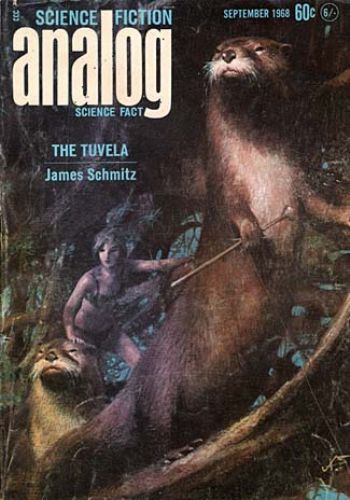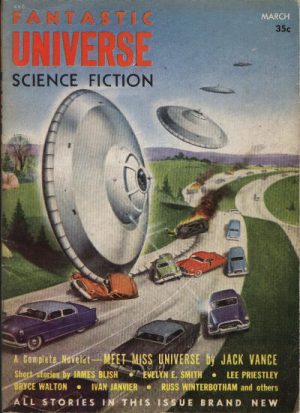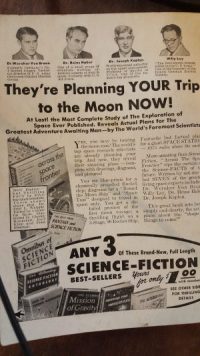Greetings all
This week I am reading Analog, Vol. LXXXII, No.1 (September, 1968). This, and others in this time period interest me, because I was a month or two old when it hit the stands.
Table of Contents: http://www.isfdb.org/cgi-bin/pl.cgi?56820

This has been my favorite cover so far. Unfortunately, it doesn’t show well online, as the colors are fairly dark. However, it has giant otters and one’s carrying a trumpet. How cool is that?
The giant otters show up in the first part of The Tuvela by James Schmitz, which starts the issue off. The two parts are later expanded to become The Demon Breed. I’ve been exposed to only a little of Schmitz before, mostly through the Telzey and Trigger republishing by Baen which you can find here: https://www.baen.com/original-edition-of-edited-schmitz-stories.html.
Now, one would expect that if a serial was turned into a full-length novel, it was probably a pretty good story. And one would be correct, at least in the case of Tuvela. I really enjoyed the first part, am looking forward to finding the second part, and may just skip ahead and read The Demon Breed instead.
The story involves a race called the Parahuans, who had attacked humanity previously and been defeated. How the humans won puzzled them, as in their world view they were the most superior creatures in existence. However, they hypothesize that humanity is controlled by a greater version of humans called the Guardians or the Tuvela. They choose to test this hypothesis out on a water planet called Nandy-Cline.
This hypothesis is crap, of course, but it gives our heroes a chance to bluff the Parahuans into not attacking again. Schmitz does a fantastic job of giving us active prose when much of it is solving a puzzle.
As part of this story, our heroes are aided by otters that have quickly evolved on Nandy-Cline to be intelligent at some level. At this point, we don’t really know just how smart they are, but we can guess they are very smart indeed. I suspect there’s a twist coming related to them in the final part of the story. I look forward to reading it.
The next story is by Harry Harrison and is called The Powers of Observation. Obviously, Harrison is remembered most by the Stainless Steel Rat, which I read a long time ago and clearly need to read again.
This story, however, is actually set in a Cold War Yugoslavia. As such this lets me do one of my favorite tricks when it comes to reading books now, and that’s looking at the satellite imagery of places that are mentioned. The Powers of Observation gives me a cool one by mentioning the Maslenica Bridge. Why is this cool? Well, that bridge has its own story to tell. It was destroyed in the war, a new one was built in 1997 near it, and then a new version of the old one was built later on. I find that sort of thing fun, call me crazy, and in any case I was able to follow the chase in the story from the sky.
Chase? Oh, yeah, the story itself, I should talk about that. It’s a very Bond kind of story where the hero spots a man sinking too deep into the sand at a beach. Some kind of superman, dense bone structure or something. Anyway, the hero has to chase him down, which he eventually does and they get into a fight. He shoots the bad guy but bullets bounce off of him, and we discover he’s a robot.
Our hero manages to defeat him, and then tears him apart to get pictures of his engineering. He takes a bunch of pictures with his chest camera. Chest camera? Oh, our hero was a robot too, and Harrison lets him sneer at the difference between Russian and American design philosophies at the end. I was so caught up in the chase that I didn’t see the hints until until I went back later.
Wallace West is next with Steamer Time. I’d not heard of West prior to this. He wrote quite a few stories in the 50s and before. This particular one is an essay on the possibility of replacing internal combustion engines with steam engines in cars. I was kind of bemused by the idea, but there are advantages to steam power.
One that West focuses on is emissions, based on the Air Quality Act of 1967 in response to the smog in California at the time. There are a number of other technical topics I’m not smart enough to grasp, but it’s an interesting topic. I’ve no clue if this is practical now or not, but there were steam-powered cars built in the 1960s so there’s probably a way to do that engineering now.
The next section is John Campbell’s column on what’s coming next. The following issue includes a Poul Anderson story about the effects of a fairly close supernova’s radiation effects on Earth. Also here are the tallied ratings for the June, 1968 issue in which Poul Anderson’s Satan’s World took first place.
Back to this issue, we move on to Peter Abresch’s Hi Diddle Diddle. Abresch is mostly a mystery writer, with only a couple of SF short stories to his credit. After this, I’m definitely looking up his mysteries.
The story begins when Paul Lama, an Air Force reservist, tasked with tracking down UFO reports is thrust into a press conference with hostile press trying to trick him into admitting there are aliens. So he does. He says the aliens exist but they’re actually animals that evolved to live in space. Spacecows.
Lama expects the press to double-check, in which case they find out it’s baloney. The press, of course, does not, and everyone who hears about this gets sent into a tizzy, including Senators and the like wondering why they’re hearing classified info on TV. Spacecows everywhere. I can only imagine what that would be like in today’s media.
And it’s hilarious. The President hears about it from his dog-walker (p. 107). One senator feels, “…like he had just found out the Statue of Liberty was an unwed mother” (p. 107). Russian spies find out from their doorman. “When Isvestia says we know everything, it means we know nothing, and when the Air Force says they know nothing, it means they know something” (p. 124).
Later on, there’s this hilarious sequence where Lama gets tracked down first by the reporter who’s staking his career on the actual existence of spacecows, then Russian spies come in and say, “You Lama?” to which he replies. “Me Lama, you Jane?” This gets repeated when the FBI barge in. Then we get an Air Force captain that later comes on stage and says, “You Lama?” “Me Lama, you Jane?” “Yeah, Melvin Jayne, how’d you know?”
In the chaos, Lama’s secretary Jimmi manages to help him escape, but it turns out that Lama was just about right and Jimmi is one of the spacecows. His guess has forced her species to leave one of the best pastures in the galaxy and ruined her student grant project.
Great story.
The next story is Stanley Schmidt’s first story ever, called A Flash of Darkness. This story is about a Mars Rover who sees in darkness by, essentially, lidar. However, he discovers another light source that is blinding him with too much light. The robot discovers the problem and navigates to find solar cells.
This story seems incomplete. It’s the kind of thing James P. Hogan had a blast with in the Giants series, but Schmidt doesn’t go far enough. The Rover discovers something that requires intelligence to craft on Mars. Who made it? We don’t know. I wanna know.
Parasike by Michael Chandler is next. I had not heard of Chandler before and can’t find him on the internet. I don’t think he’s the Old West gunfighter reenactor writing westerns, at least.
Anyway, this story is about a new investigator for a federal Fraud agency. He’s tasked with finding fortunetellers and the like who are trying to bilk customers. What he’s actually looking for are people who have a paranormal skill. These often use such jobs as fortuneteller or magician to hide their abilities. The twist is that our hero can tell when people are telling the truth, so not only does he discover one parasike, he discovers he is one too.
The next section is the review section by P. Schuyler Miller. He starts with a discussion of a number of fun series out there including Doc Savage and Conan. He then reviews a number of books. The review I found most interesting was his review of Philip K. Dick’s Do Androids Dream of Electric Sheep. He sums it up by saying it might take a couple of reads to really understand what Dick was saying, but that we should “Try it” (p. 171). I agree.
Then we’re to the Brass Tacks section, which are the letters to the editors. This set of letters has a theme. Apparently Campbell asked in the April, 1968 what “widdershins” meant and what word is the reverse. Campbell got a flood of responses, all interesting to an etymology geek like me.
Overall, this was a great issue. It’s only drawback was its lack of striking advertisements. Inside the back cover is one that says we should “Discover America, it’s 3000 smiles wide.” I kind of like that.
However, that’s clearly a minor thing when you look at the great stories here.
Next week, we’ll look at the Galaxy of August, 1962. It inlcudes Frederik Pohl, Jack Vance, and Willy Ley. It’s full table of contents is here: http://www.isfdb.org/cgi-bin/pl.cgi?58677. See you then.
If you have any comments, feel free to comment here or send an email to me at: rob@robhowell.org.
If you want to see previous reviews, the Mag Review category is here: https://robhowell.org/blog/?cat=432.


